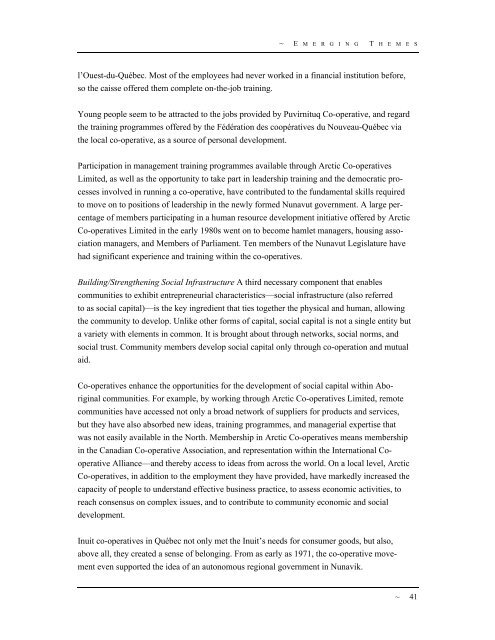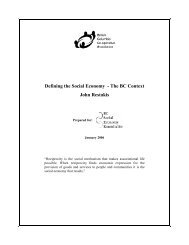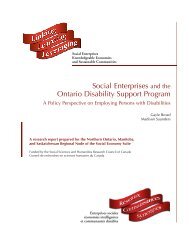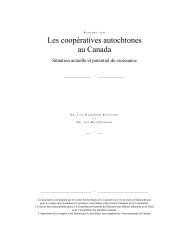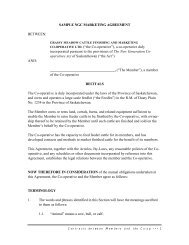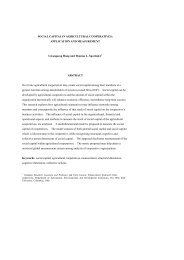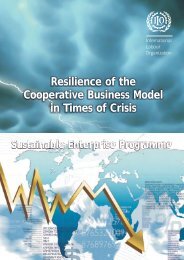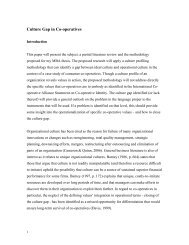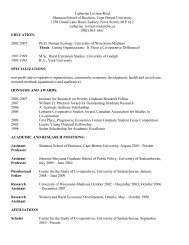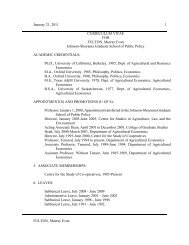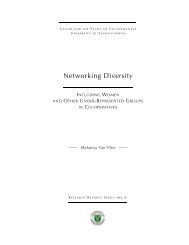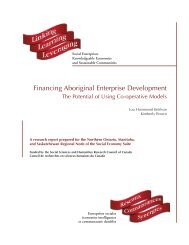Aboriginal Co-operatives in Canada - Centre for the Study of Co ...
Aboriginal Co-operatives in Canada - Centre for the Study of Co ...
Aboriginal Co-operatives in Canada - Centre for the Study of Co ...
Create successful ePaper yourself
Turn your PDF publications into a flip-book with our unique Google optimized e-Paper software.
~ E M E R G I N G T H E M E Sl’Ouest-du-Québec. Most <strong>of</strong> <strong>the</strong> employees had never worked <strong>in</strong> a f<strong>in</strong>ancial <strong>in</strong>stitution be<strong>for</strong>e,so <strong>the</strong> caisse <strong>of</strong>fered <strong>the</strong>m complete on-<strong>the</strong>-job tra<strong>in</strong><strong>in</strong>g.Young people seem to be attracted to <strong>the</strong> jobs provided by Puvirnituq <strong>Co</strong>-operative, and regard<strong>the</strong> tra<strong>in</strong><strong>in</strong>g programmes <strong>of</strong>fered by <strong>the</strong> Fédération des coopératives du Nouveau-Québec via<strong>the</strong> local co-operative, as a source <strong>of</strong> personal development.Participation <strong>in</strong> management tra<strong>in</strong><strong>in</strong>g programmes available through Arctic <strong>Co</strong>-<strong>operatives</strong>Limited, as well as <strong>the</strong> opportunity to take part <strong>in</strong> leadership tra<strong>in</strong><strong>in</strong>g and <strong>the</strong> democratic processes<strong>in</strong>volved <strong>in</strong> runn<strong>in</strong>g a co-operative, have contributed to <strong>the</strong> fundamental skills requiredto move on to positions <strong>of</strong> leadership <strong>in</strong> <strong>the</strong> newly <strong>for</strong>med Nunavut government. A large percentage<strong>of</strong> members participat<strong>in</strong>g <strong>in</strong> a human resource development <strong>in</strong>itiative <strong>of</strong>fered by Arctic<strong>Co</strong>-<strong>operatives</strong> Limited <strong>in</strong> <strong>the</strong> early 1980s went on to become hamlet managers, hous<strong>in</strong>g associationmanagers, and Members <strong>of</strong> Parliament. Ten members <strong>of</strong> <strong>the</strong> Nunavut Legislature havehad significant experience and tra<strong>in</strong><strong>in</strong>g with<strong>in</strong> <strong>the</strong> co-<strong>operatives</strong>.Build<strong>in</strong>g/Streng<strong>the</strong>n<strong>in</strong>g Social Infrastructure A third necessary component that enablescommunities to exhibit entrepreneurial characteristics—social <strong>in</strong>frastructure (also referredto as social capital)—is <strong>the</strong> key <strong>in</strong>gredient that ties toge<strong>the</strong>r <strong>the</strong> physical and human, allow<strong>in</strong>g<strong>the</strong> community to develop. Unlike o<strong>the</strong>r <strong>for</strong>ms <strong>of</strong> capital, social capital is not a s<strong>in</strong>gle entity buta variety with elements <strong>in</strong> common. It is brought about through networks, social norms, andsocial trust. <strong>Co</strong>mmunity members develop social capital only through co-operation and mutualaid.<strong>Co</strong>-<strong>operatives</strong> enhance <strong>the</strong> opportunities <strong>for</strong> <strong>the</strong> development <strong>of</strong> social capital with<strong>in</strong> <strong>Aborig<strong>in</strong>al</strong>communities. For example, by work<strong>in</strong>g through Arctic <strong>Co</strong>-<strong>operatives</strong> Limited, remotecommunities have accessed not only a broad network <strong>of</strong> suppliers <strong>for</strong> products and services,but <strong>the</strong>y have also absorbed new ideas, tra<strong>in</strong><strong>in</strong>g programmes, and managerial expertise thatwas not easily available <strong>in</strong> <strong>the</strong> North. Membership <strong>in</strong> Arctic <strong>Co</strong>-<strong>operatives</strong> means membership<strong>in</strong> <strong>the</strong> Canadian <strong>Co</strong>-operative Association, and representation with<strong>in</strong> <strong>the</strong> International <strong>Co</strong>operativeAlliance—and <strong>the</strong>reby access to ideas from across <strong>the</strong> world. On a local level, Arctic<strong>Co</strong>-<strong>operatives</strong>, <strong>in</strong> addition to <strong>the</strong> employment <strong>the</strong>y have provided, have markedly <strong>in</strong>creased <strong>the</strong>capacity <strong>of</strong> people to understand effective bus<strong>in</strong>ess practice, to assess economic activities, toreach consensus on complex issues, and to contribute to community economic and socialdevelopment.Inuit co-<strong>operatives</strong> <strong>in</strong> Québec not only met <strong>the</strong> Inuit’s needs <strong>for</strong> consumer goods, but also,above all, <strong>the</strong>y created a sense <strong>of</strong> belong<strong>in</strong>g. From as early as 1971, <strong>the</strong> co-operative movementeven supported <strong>the</strong> idea <strong>of</strong> an autonomous regional government <strong>in</strong> Nunavik.~ 41


